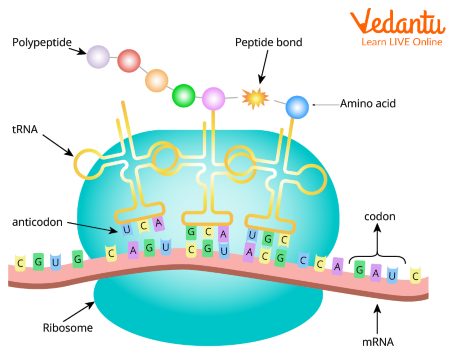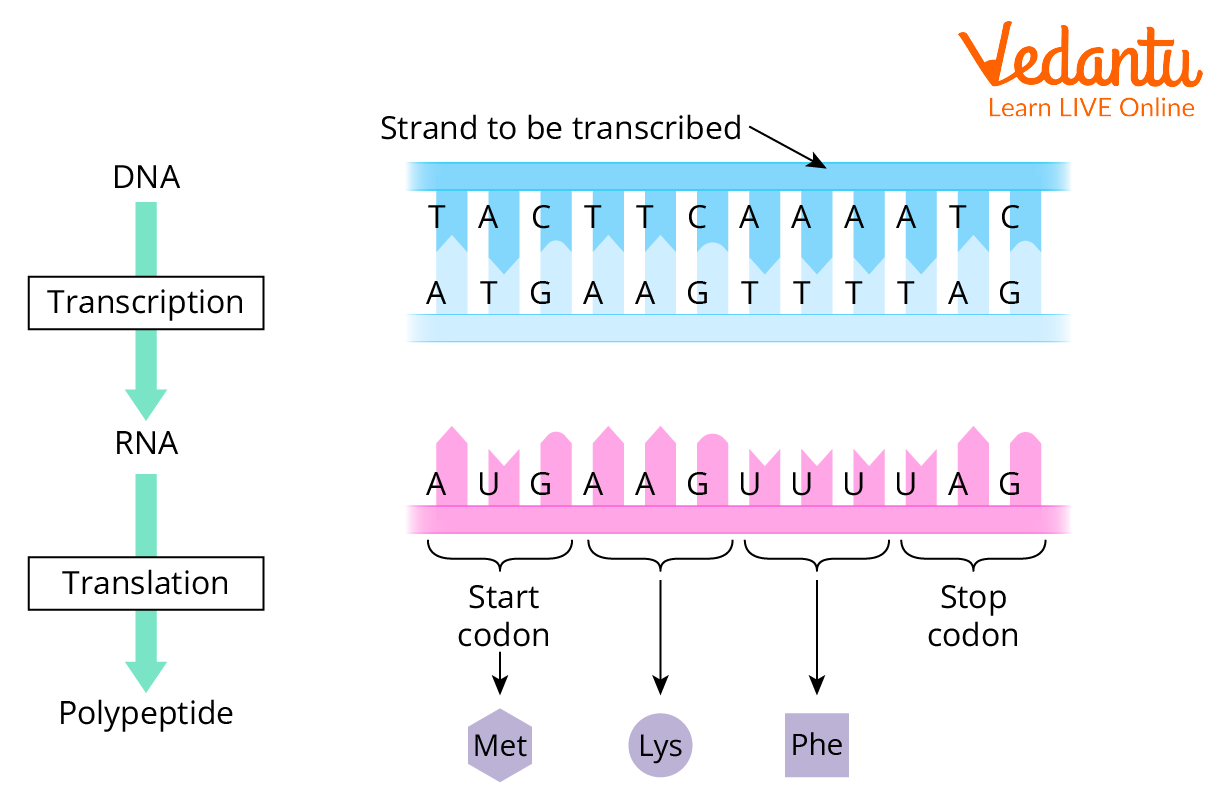How Do Start Codons Signal the Beginning of Translation?
A codon is a three-letter gene sequence found in RNA and DNA. An example of a codon is the sequence AUG. There are three types of codons: start codons, stop codons, and normal codons. Each three-letter mRNA nucleotide sequence corresponds to a specific amino acid or stops codon. UGA, UAA, and UAG are stop codons. AUG is a methionine codon and a start codon.

Codon in Ribosome
Definition of Codon
A codon is a specific nucleotide sequence in an mRNA that corresponds to a specific amino acid or stop signal during protein translation. Nucleotides are then made up of nitrogenous base codons, a three-letter gene sequence found in RNA and DNA. An example of a codon is the sequence AUG. There are three types of codons: start codons, stop codons, and normal codons. Each three-letter mRNA nucleotide sequence corresponds to a specific amino acid or stops codon. UGA, UAA, and UAG are stop codons. AUG is a methionine codon and a start codon.es (or simply bases), sugars and phosphate groups.
How many nucleotides does a codon consist of? Now we can say that a sequence of 3 nucleotides constitutes a codon or a sequence of 3 nucleotides constitutes an mRNA codon. The major nitrogenous bases in RNA nucleotides are
Adenine (A)
Uracil (U)
Guanine (G)
Cytosine (C)
Therefore, a representative example of the genetic code is the triplet code. B. Codes for specific amino acids, including adenine-uracil-guanine (AUG), uracil-cytosine-cytosine (UCC), and uracil-guanine-adenine (UGA). A codon is the smallest unit of the genetic code because the set of codons in mRNA makes up the genetic code.
Simply put, each codon actually encodes a specific amino acid. It is also possible to encode signals that stop or start intracellular protein synthesis processes.
Start Codons and Stop Codons
Start Codon
The AUG codon is called the start codon. This is the first codon to be translated into the transcribed mRNA. AUG is the most common start codon and code for the eukaryotic amino acid methionine (Met) and prokaryotes formylmethionine (fMet). During protein synthesis, tRNA recognizes the AUG start codon through several initiation factors and initiates the translation of mRNA.
Some alternative start codons are found in both eukaryotes and prokaryotes. The replacement codon normally codes for an amino acid other than methionine, but acts as a start codon and uses a separate start tRNA to encode Met.
Stop Codons
There are three stop codons in the genetic code: UAG, UAA, and UGA. This codon marks the end of the polypeptide chain during translation. Because this codon does not code for an amino acid, it is also known as a nonsense codon or stop codon. The three stop codons were named amber (UAG), opal or amber (UGA), and other (UAA).
During protein synthesis, a stop codon triggers the release of a new polypeptide chain from the ribosome. This is because the tRNA does not have an anticodon complementary to the stop codon.

Start and Stop Codon
Difference between Start and Stop Codons
The difference between the two codons are as follows:
Interesting Facts
Discovery of Start Codon
In 1964 Nirenberg and Philip Leder, a postdoctoral fellow at National Institutes of Health, discovered some way to work out the sequence of the letters in every triplet word for amino acids. By 1966 Nirenberg had deciphered the sixty four ribonucleic acid three-letter code words (codons) for all twenty amino acids.
Important Questions
1. What are the salient features of the genetic code?
Ans: This is a triplet with 61 codons coding for amino acids and 3 codons not coding. So they act as stop codons.
Codons are unambiguous and specific because they code for only one amino acid.
Codons are read sequentially from the mRNA. There are no punctuation marks.
Some amino acids are encoded by multiple codons, which degenerates the encoding.
The code is almost universal. From bacteria to humans, for example, UUUs encode phenylalanine (Phe). Some exceptions are found in mitochondrial codons and some protozoa.
AUG has two functions. It codes for methionine (Met) and also functions as a start codon.
2. Given below are the sequence of nucleoside in a particular mRNA and amino acids coded by it UUUAUGUU CGAGUUAGUGUAA Phe – Met – Phe – Glu – Leu – Val. Write the properties of genetic codes that can be and that cannot be correlated from the above-given data.
Ans: UUUAUGUUCGAGUUAGUGUAA Phe-Met-Phe-Glu-Leu-Val According to the above sequence:
The codon is a triplet.
The genetic code is specific and clear. For example, the code AUG-methionine (Met) code.
GAG-glutamine (Glu) code UUA-leucine (Leu) is degenerate.
The same amino acid is encoded by multiple codes. For example, UUU and UUC are the codes for phenylalanine (Phe).
Code is read without punctuation.
Thus, all properties of the codon are satisfied from the above-given data. Except for the one that mostly AUG works as an initiating codon.
Practice Questions
Mention the role of the codons AUG and UGA during protein synthesis.
Mention the contribution of genetic maps in the human genome project.
What is the function of Codon AUG?
Answers
AUG Acts as an initiation codon and codes for amino acid methionine. UGA Acts as a stop/termination codon that signals the termination of polypeptide synthesis.
Genetic maps are used as a starting point in the sequencing of whole genomes.
Codes for methionine and is the starting point of protein synthesis (initiation codon).
Key Features
The genetic code has two punctuation marks: the start codon and the stop codon
Codons in all organisms indicate the end of protein synthesis.
The start codon indicates the point at which translation into the protein sequence begins.
The stop codon indicates the point at which translation ends.


FAQs on Start Codons in DNA and RNA: Key to Protein Synthesis
1. What are the start codons in DNA and RNA, and what is their primary function?
The primary start codon in messenger RNA (mRNA) is AUG. In the corresponding DNA sequence from which it is transcribed, this codon is represented as ATG on the coding strand. Its main function is to signal the beginning of protein synthesis, a process called translation. It critically establishes the correct reading frame for the ribosome, ensuring the mRNA is read accurately in groups of three nucleotides.
2. Why is the start codon written as ATG for DNA but AUG for RNA?
The difference arises from the distinct chemical composition of the nucleic acids. DNA (Deoxyribonucleic acid) contains the four nitrogenous bases: Adenine (A), Guanine (G), Cytosine (C), and Thymine (T). In contrast, RNA (Ribonucleic acid) uses Uracil (U) in place of Thymine. Consequently, the three-base sequence that signals the start of a gene is ATG in the DNA code, which is then transcribed into the AUG codon in the mRNA molecule.
3. What is a stop codon, and how does it differ from a start codon?
A stop codon, also called a termination codon, is a three-nucleotide sequence in an mRNA strand that signals the ribosome to terminate protein synthesis. The key differences from a start codon are:
- Function: A start codon (AUG) initiates translation and begins the polypeptide chain, whereas a stop codon (UAA, UAG, or UGA) halts the process and releases the completed chain.
- Coding: The start codon AUG codes for the amino acid Methionine (or formylmethionine in prokaryotes). Stop codons are often called 'nonsense codons' because they do not code for any amino acid; they are recognized by release factors instead.
- Quantity: There is predominantly one main start codon (AUG), but there are three distinct stop codons in the standard genetic code.
4. What amino acid does the start codon AUG code for?
The start codon AUG performs a dual function. It acts as the primary initiation signal for translation and also codes for the amino acid Methionine in eukaryotes. In prokaryotic organisms, such as bacteria, it codes for a modified version called formylmethionine (fMet). This ensures that Methionine is the first amino acid incorporated into virtually every newly synthesized polypeptide chain.
5. Does translation always begin at the very first AUG codon on an mRNA strand?
No, translation does not necessarily start at the first AUG from the 5' end of the mRNA, especially in eukaryotes. The ribosomal machinery typically scans the mRNA for an AUG codon that is situated within an optimal context, known as the Kozak consensus sequence. This sequence helps the ribosome distinguish a true initiation codon from an internal AUG that simply codes for a Methionine residue within the protein's sequence.
6. Since AUG codes for Methionine, does every functional protein in our body start with Methionine?
While it is true that almost all protein synthesis initiates with Methionine, not all mature, functional proteins retain it as their first amino acid. In many instances, the initial Methionine residue is cleaved off the polypeptide chain shortly after translation. This removal is a type of post-translational modification, a crucial step that many proteins undergo to become fully active and functional in the cell.
7. What are the key properties of the genetic code demonstrated by start and stop codons?
Start and stop codons perfectly illustrate several fundamental properties of the genetic code:
- Specificity: The code is highly specific. The start codon AUG unambiguously codes for Methionine, and stop codons specifically signal termination without coding for an amino acid.
- Non-overlapping: The start codon establishes the reading frame. From that point, the ribosome reads the mRNA in successive, non-overlapping triplets until it encounters a stop codon, preventing frame-shift errors.
- Universality: The meaning of the start codon AUG and the three stop codons is nearly universal across all known forms of life, providing powerful evidence for a common evolutionary ancestry.
8. Are there any exceptions to AUG being the start codon?
Yes, while AUG is overwhelmingly the most common start codon, rare exceptions do occur in both prokaryotes and eukaryotes. In some specific genes, codons such as GUG (which normally codes for Valine) or CUG (which normally codes for Leucine) can function as alternative initiation codons. Interestingly, even when these codons act as the starting signal, the cell's machinery usually still incorporates Methionine (or fMet) as the first amino acid, highlighting the system's robust mechanism for initiating protein synthesis.










